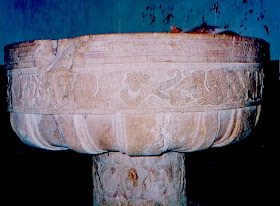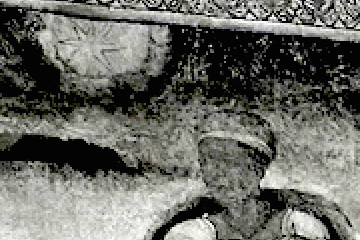 |
| San Juan Culhuacan, from the Uppsala map (1550) |
Although it has undergone structural changes over the centuries, the rugged Augustinian monastery of San Juan Culhuacan in Mexico City, hewn from coarse black lava, conveys the same timeless monumentality as the few surviving Aztec structures scattered throughout the valley.
The Convento Murals
Although some were lost over the years to reconstruction, neglect and ill considered over painting, and many remain only fragmentary, the bleak convento is brightened by numerous 16th century murals in a mixture of styles and colors. Executed in fresco de secco—paint applied to dry instead of wet plaster—they picture a wide range of classic stories and themes dear to the Augustinian Order.
Around the upper cloister, large Renaissance inspired scenes from the Life and Passion of Christ are interposed with medieval style portraits of Augustinian saints and martyrs. In contrast to to the multicolored murals of the lower level, the frescoes here are entirely monochromatic, beautifully drawn and highly detailed in warm grisaille tones, and framed by lively grotesque panels and running foliated friezes.
In this seasonal post we focus on the elegant Adoration of the Magi in the southwest corner, the most complete of the compositions. The Holy Family, serenely posed on the left with lowered eyes, rests in a surprisingly well appointed structure of uncertain perspective.
The elegantly robed Three Kings on the right, two standing and one kneeling, are skillfully portrayed in careful detail with their costumes and gifts.Star of Bethlehem; Cerro de la Estrella
Three horses prance on the extreme right, with the Star of Bethlehem in the center hanging above a prominent hill—evoking the sacred local landmark of the Cerro de la Estrella, site of the Aztec New Fire ceremony, which appears in other murals at Culhuacan.
text © 2016 Richard D. Perry
images courtesy of Niccolò Brooker













































